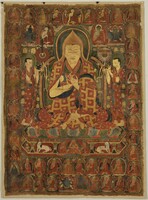Je Tsongkapa with the Yogachara & Madhyamaka Lineages

Lama Tsongkapa, Lobzang Dragpa, also known as Je Rinpoche (1357-1419): founder of the Gelug School of Tibetan Buddhism. Tsongkapa established the Ganden Monastery in central Tibet in 1409 which became the principal seat of the Gelug School. Beginning with Tsongkapa, each of the successive Throne Holders of Ganden Monastery are considered the heads of the Gelug Tradition. In these early compositions Tsongkapa is portrayed as the principal figure along with the two most important disciples standing at the right and left, accompanied by the two most important groups of lineage teachers from India known as the Yogachara and Madhyamaka philosophical lineage traditions.
The subject of the composition of these paintings is not unique although somewhat rare. At least seven other paintings are known from the 15th and 16th century time period that depict this same subject of Tsongkapa accompanied by the Yogachara and Madhyamaka lineages. The Yogachara and Madhyamaka philosophical traditions are the highest and most advanced teachings of Mahayana Buddhism, recognized by all Tibetan Buddhist schools, and paintings such as these re-enforce the importance the Gelug Tradition placed on such teachings as opposed to the Tantric teachings emphasized by the Nyingma, Sakya, Kagyu and Jonang traditions of Tibetan Buddhism.
The general style of composition in these and other similar paintings was discontinued after the late 17th century with the development of the compositional style known as the Gelug 'Field of Accumulation' created by the 1st Panchen Lama, Lobzang Chokyi Gyaltsen (1570-1662). The new Field of Accumulation composition (sometimes known as a Refuge Field) included both important Yogachara and Madhyamaka lineages along with the principal lineage of the Gelug school known as the Stages of the Path. A further elaboration in the new composition was the addition of three groups of religious figures and objects representing the all important Buddha, Dharma (represented by books depicted in a Tibetan style) and Sangha (represented by the Sixteen Arhats and the Eight Great Bodhisattvas). Further additions to the composition format were the most important Tantric deities of the Gelug school along with the three principal protector deities: Shadbhuja Mahakala, Yama Dharmaraja and Vaishravana Riding a Lion.
